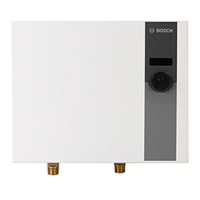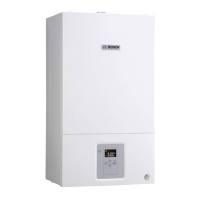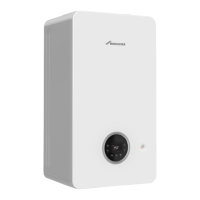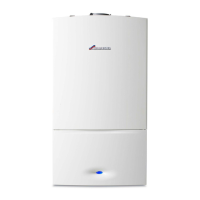Flue gas testing | 23
8 716 473 216 (2014/09)Gaz 6000 W
Resetting the appliance to standard operating mode
▶ Select service function 1.2.F and operating mode 00 (= standard
mode) ( page 19).
▶ Switch off the appliance, close the gas valve, remove the pressure
gauge and tighten the sealing screw.
▶ Reattach the cover and seal it.
11 Flue gas testing
11.1 Setting the appliance output
To select the maximum appliance output:
▶ Select service function 1.2.F and operating mode 04 ( page 19).
To select the minimum appliance output:
▶ Select service function 1.2.F and operating mode 03 ( page 19).
To select Standard mode:
▶ Select service function 1.2.F and operating mode 00 ( page 19).
-or-
▶ Press standby.
The boiler returns to standard mode.
11.2 Testing for flue gas tightness
An annular gap probe is required for carrying out the test.
This test is only possible with flue routing type C
12
and C
32
.
The O
2
level must not be below 20.6 %. The CO
2
level must not exceed
0.2 %.
▶ To ensure heat transfer, open radiator valves or hot water draw-off
point.
▶ Switch on the appliance and wait a few minutes.
▶ Remove the sealing plug from the combustion air testing socket (2).
▶ Insert the probe into the test port.
Fig. 25
[1] Test port for flue gas
[2] Test port for combustion air
▶ Seal the test port.
▶ Select service function 1.2.F and operating mode 04 ( page 19).
▶ Measure the O
2
or CO
2
level.
▶ Select service function 1.2.F and operating mode 00 ( page 19).
▶ switch off the appliance.
▶ Remove the probe.
▶ Refit plug.
11.3 Measuring CO level in flue gas
A multi-port probe is required for carrying out the test.
▶ To ensure heat transfer, open radiator valves or hot water draw-off
point.
▶ Switch on the appliance and wait a few minutes.
▶ Remove the sealing plug from the flue gas testing socket (1).
▶ Insert the probe as far as it will go into the test port.
▶ Seal the test port.
▶ Select service function 1.2.F and operating mode 04 ( page 19).
▶ Measure the CO level.
▶ Select service function 1.2.F and operating mode 00 ( page 19).
▶ switch off the appliance.
▶ Remove the probe.
▶ Refit plug.
Fig. 26
[1] Test port for flue gas
[2] Test port for combustion air
11.4 Measuring flue gas loss
A flue gas probe and a temperature sensor are required for carrying out
the test.
▶ To ensure heat transfer, open radiator valves or hot water draw-off
point.
▶ Switch on the appliance and wait a few minutes.
▶ Remove the sealing plug from the flue gas testing socket (1).
▶ Insert the flue gas probe approx. 60 mm into the test port or to the
position at which the flue gas temperature is highest.
▶ Seal the test port.
▶ Remove the sealing plug from the combustion air testing socket (2).
▶ Push the temperature sensor approx. 20 mm into the port.
▶ Seal the test port.
▶ Select service function 1.2.F and operating mode 04 ( page 19).
▶ Measure the flue gas loss or boiler efficiency at a boiler temperature of
60 °C.
▶ Select service function 1.2.F and operating mode 00 ( page 19).
▶ switch off the appliance.
▶ Remove the probe.
▶ Remove the temperature sensor.
▶ Refit plug.
Never commission the appliance above or below these
values. Identify the cause and rectify the fault. Where that
is not possible, isolate the appliance from the gas side
and notify the customer.
You have 15 minutes in which to take your
measurements. Afterwards, the appliance returns to
standard mode.
You can test for flue gas tightness by measuring the O
2
or
CO
2
content of the combustion air.
FLUE
FLUE
8 716 473 216-17.1O
12
FLUE
FLUE
8 716 473 216-17.1O
12

